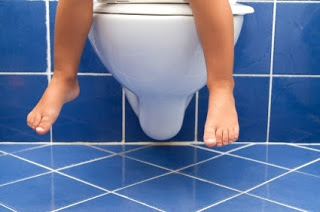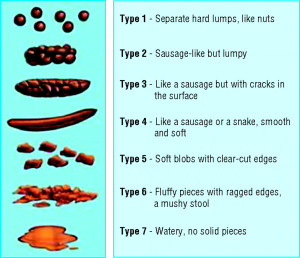 Posted April 21, 2014 | Nutrition & Health Tips
Posted April 21, 2014 | Nutrition & Health Tips
Many people are grossed out by poop and it is not often a daily conversation. We all poop though, and when people are embarrassed to talk about it, a lot can get missed. Our bowel movements are the best and easiest way to track your gastrointestinal health daily (hopefully). We need to stop avoiding our voids and start appreciating them for the great resource of information they are.
The average person will produce 9,000 pounds of poo per year! There are a lot of indicators of health in all of those pounds. There are several aspects of the bowel movement that should be considered when assessing health. We should think about the shape, size, smell, shade and frequency of our waste. Several things come into play that determine these outcomes such as probiotic levels in the gut, digestive enzymes, muscle tone, dysbiosis of yeast or bad bacteria, parasites, food allergies or sensitivities, medications, and intestinal immune health. When we eat our food it travels an average of 30 feet going through our intestines before coming out the other end about 40-45 hours later. Along the way, it gets rumbled and tumbled as nutrients are absorbed and toxins are eliminated. Your stool should come out not looking like a stool, but more like a torpedo or a banana; Nice and round in the middle and tapered on both ends. This is a sign that there is just enough water in the stool to keep it soft but well formed and that the inside of the colon is free and clear. You can reference the Bristol Stool Chart to assess where your poop falls in the scale of healthy.
Little lumps:
This is a sign of constipation. The poop is sitting around in the intestines too long and water is being reabsorbed, leaving these tiny round rabbit pellets. This can also be a sign of low probiotic flora in the bowel that helps keep water around. You are also likely to experience little to no flatulence as with decreased probiotics, there is no fermentation occurring releasing gas into the intestines. The opposite may be present as well if dysbiosis has occurred causing excess foul smelling gas. A diet low in fiber can also be why stools become lumpy. This is often seen in standard American diets or more specialty diets like Atkins where the focus is on protein, and fiberous foods are lacking.
Clumped lumps:
When you have a lot of little pellets all clumped together, it is also a sign of constipation, with causes similar to the ones mentioned above. The motility of bowels through the intestines is likely extended to at least 72 hours or more in this scenario, allowing for water to be reabsorbed. When the whole body is lacking in water, it goes on a search to find a reservoir, and takes it from the bowels to use to nourish other higher functioning organs and metabolism processes. This presentation is usually very large and can cause a lot of destruction on the way out such as lacerations, prolapse and hemorrhoids. It is important to eat plenty of fiber, drink lots of water and make sure to be getting daily sources of probiotics.
Too Much Liquid:
This doesn’t mean that you are drinking too much water in the inverse of constipation. Having completely liquid stools most likely indicates a gastrointestinal infection. It is important to remember to stay hydrated and get electrolytes and seek medical care as needed. This presentation, along with all poop forms, can be a side effect of medications, so it is important to note if it correlates with a new or higher dose of a medication. When the stool still has substance but is liquidy, this can be due to many reasons. It can be a sign of infection, but it could also be from stress, a laxative, and eating spicy food. It is hard to hold the urge to poop, and often hard to clean up. Additionally, always having diarrhea may actually be a sign of chronic constipation where only the liquid is able to get around a hard solid mass of poop blocking the exit. Ask your doctor for more information and assessment for this one.
Floats, and Likely Stinks:
Floating is a sign of fat in the stool and that your body is not digesting dietary fats properly. The ideal torpedo shaped bowels should hit and sink when expelled. The stool can often look greasy, yellowish in color and smell quite foul. Many important vitamins including A, E, D and K are fat soluble, and therefore may be lacking in absorption as well. These symptoms can also be seen from eating foods that contain olestra, a faux fat found in chips and other fried snacks, or from weight loss drugs like Alli, that prevent fat absorption.
Pencil Thin:
While we want many things to be very thin and small like cell phones or TV screens, our bowels are not one of them. When they are really thin consistently, this could be a sign of an obstruction in the colon. There is something on the wall of the colon that the poop is getting pushed against making it change shape to be smaller to get by. This is time to go see your doctor for a work up.
Non-Existent:
If you are consistently seeing the incredible magic act of making food disappear never to be seen again, well we have a problem. The healthy frequency that people go depends on the individual. Ideally, everyone is going 1-2 times per day. When we aren’t having a bowel movement daily, we are not getting rid of our toxins and they are building up and can even be reabsorbed. This can affect us on a grand scale making us feel sluggish and fatigued with higher levels of inflammation and decreased immune system… and more. It is important to remember not to take a stimulant laxative if you are not having a bowel movement as we do not want to put a lot of pressure behind the flood gates until we know that they are able to open.
It is important to consider this critical information that can be dispelled from our poop. While it doesn’t necessarily need to be the new question asked at the family dinner table, “How was your poop today, dear?”, checking in to make sure everyone is regular is a good idea. The next time you go number two, take two seconds to give it a look over and see what you can tell about your health.
Stay tuned for part II of our discussion about number two with our next blog.
This is one of the most informative and simple explanations that really answered a lot of questions that I have been embarrassed to ask. Thanks a bunch.